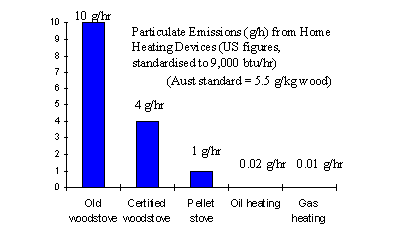Wood vs other forms of
heating
 The bar chart,
based on a leaflet from the Puget Sound Air Pollution control
agency compares particulate emissions from various forms of home
heating. US EPA certified heaters produce similar amounts of
pollution to heaters satisfying the latest Australian standard.
This means 10 houses heated with correctly operated certified
woodstoves produce as much pollution as 4,000 houses heated with
natural gas.
The bar chart,
based on a leaflet from the Puget Sound Air Pollution control
agency compares particulate emissions from various forms of home
heating. US EPA certified heaters produce similar amounts of
pollution to heaters satisfying the latest Australian standard.
This means 10 houses heated with correctly operated certified
woodstoves produce as much pollution as 4,000 houses heated with
natural gas.
The Australian standard for particulate emission from
woodstoves (AS4013) is for a maximum of 5.5 g / kg of wood
burned, averaged over the complete burn cycle. At a density of
500 houses per square km (2,000 square metres per house), each
house burning 1 kg per hour, 13750 grams of particulates would be
produced in 5 hours. If not dispersed but spread over the square
km to a height of 10 m, the PM2.5 concentration would be 1375
micrograms per cubic metre. The proposed Australian Federal Air
Quality standard is 50 micrograms (mcg) per cubic metre. Sydney
averages about 11 mcg/m3. It is, of course, difficult in general
to predict how the particulates will be dispersed in the air,
under different weather conditions.
Unfortunately in Armidale, the local meteorological conditions
- typically clear, still nights, with inversions - and the local
topography - a shallow basin-shaped valley - combine to produce
high concentrations of smoke on many nights during winter. For
example, in June 1997, in 11 out of the 22 nights measured, the
air pollution index for East Armidale was in the extreme
category.
What can we do?

 The bar chart,
based on a leaflet from the Puget Sound Air Pollution control
agency compares particulate emissions from various forms of home
heating. US EPA certified heaters produce similar amounts of
pollution to heaters satisfying the latest Australian standard.
This means 10 houses heated with correctly operated certified
woodstoves produce as much pollution as 4,000 houses heated with
natural gas.
The bar chart,
based on a leaflet from the Puget Sound Air Pollution control
agency compares particulate emissions from various forms of home
heating. US EPA certified heaters produce similar amounts of
pollution to heaters satisfying the latest Australian standard.
This means 10 houses heated with correctly operated certified
woodstoves produce as much pollution as 4,000 houses heated with
natural gas.